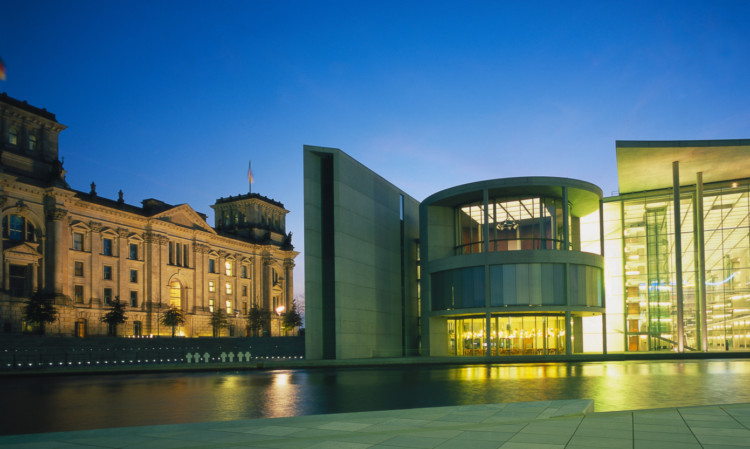
Germany is looking forward but isn’t afraid to reflect on its history.
Few cities capture the history of Europe in the 20th Century quite like Berlin.
The political and social strife and success of Germany over the past 100 years and more has played out here more than anywhere, and in its monuments, architecture, museums and exhibitions, the city is testament to that legacy.
First-timers should head for the main sights right in the heart of the city the Brandenburg Gate, Reichstag building and the Tiergarten are all within walking distance of each other, and give you a sense of Berlin’s place in modern history.
From the time the Wall went up in 1961 until its tearing down in 1989, much of this area fell into the no man’s land between the two sections, but it has since been remarkably developed and is home to a number of major foreign embassies, in addition to Peter Eisenman’s Holocaust Memorial, an indication of Germany’s willingness to reflect upon its past as well as its present dynamism.
Following the line of the former Wall will bring you to Checkpoint Charlie, where East and West once stared each other down.
Today, the landmark itself is not much more than a tourist hotspot, but the area’s museums give a much better idea of what life was like for Berliners during the Cold War, not least at the Stasi Educational Centre which highlights the chilling manner and extent to which the East German government spied upon its people.
Like Paris or London, sight-seeing in Berlin is a question of just how much you can fit in during any one stay, and the Museuminsel (Museum Island)is a good place to start.
It houses five museums four dedicated to Classical exhibitions, and the Alte Nationalgalerie, which displays a broad range of Neoclassical, Romantic and Expressionist art.
Within a stone’s throw is the German Historical Museum, where you can happily spend a day and still not see the entire display.
Berlin’s history goes beyond museums, though its architectural and design heritage is extraordinary. We all think of Italy as THE place to go for art lovers, but for design aficionados Germany is the place.
The Hufeisensiedlung (Horseshoe) housing estate in Berlin’s Charlottenburg district is a UNESCO World Heritage Site and a prime example.
Designed by Bruno Taut and built in the late 1920s, it’s one of the finest examples of the pioneering Modernist architecture that flourished in Berlin between the end of the First World War and the Nazis coming to power in 1933.
Be sure to check out the exhibition attached to the site which showcases the social history of the area, putting faces and life stories behind the doors of each residence.
The Bauhaus Archive is also located in Berlin. Showcasing the movement’s development and spread from 1919-33, the collection takes care to show the inspiration and construction of the pieces.
Anyone familiar with Charles Rennie Mackintosh’s designs will recognise his influence on the style a little bit of Scottish influence, as you find so often abroad.
There are plenty of options for accommodation in Berlin and it’s notably cheaper than other European capitals.
A little over an hour’s train ride to the south is Leipzig, home to an ancient university, an old cotton-spinning industry that, in its prime, rivalled Manchester’s, and a burgeoning arts and architectural scene.
It’s remarkable to think as you walk round the wonderfully preserved and restored city centre that this was part of East Germany just 25 years ago.
As Berlin’s reputation for stylish but inexpensive living has grown, so Leipzig and other former East German cities are now looking to attract creative talent as they regenerate.
To this end, the vast Baumwollspinnerei, a former mill, has now been transformed into a number of art studios and galleries, with more than100 artists coming from across Europe and beyond to work and display here.
The Steigenberger Grandhotel Handelshof in the former market place offers luxury with reduced winter rates a great base from which to explore. Head south-west again and a little over an hour away is Weimar.
Though it has a population of only 65,000, the town has a rich history and pride of place in German culture. It was here in 1919 that the German National Assembly met to create a new constitution after the First World War.
It counts some of the finest German minds Bach, Liszt, Goethe and Schiller, among others as former residents.
Home to the Bauhaus University, this is where Belgian architect Henry van de Veldefirst began the movement, before it was successfully championed by his successor Walter Gropius.
Tours of the campus are given by current students, though booking ahead is required.
On a smaller scale, but no less impressive is the Haus Hohe Pappeln, Van de Velde’s former family house in Weimar which he designed himself.
A fine example of art nouveau design and a combination of architecture and a philosophy for living, it offers a glimpse into the invention and prosperity of pre-1914 Germany, a spirit which is very much in evidence today.
Factbox
For further information about travel to Germany, go to germany.travel.
For more info about accommodation in Berlin, go to visitberlin.de/en.
For accommodation in Leipzig go to en.steigenberger.com/Leipzig/Steigenberger-Grandhotel-Handelshof.
For Weimar accommodation visit russischerhof-weimar.de.

Enjoy the convenience of having The Sunday Post delivered as a digital ePaper straight to your smartphone, tablet or computer.
Subscribe for only £5.49 a month and enjoy all the benefits of the printed paper as a digital replica.
Subscribe